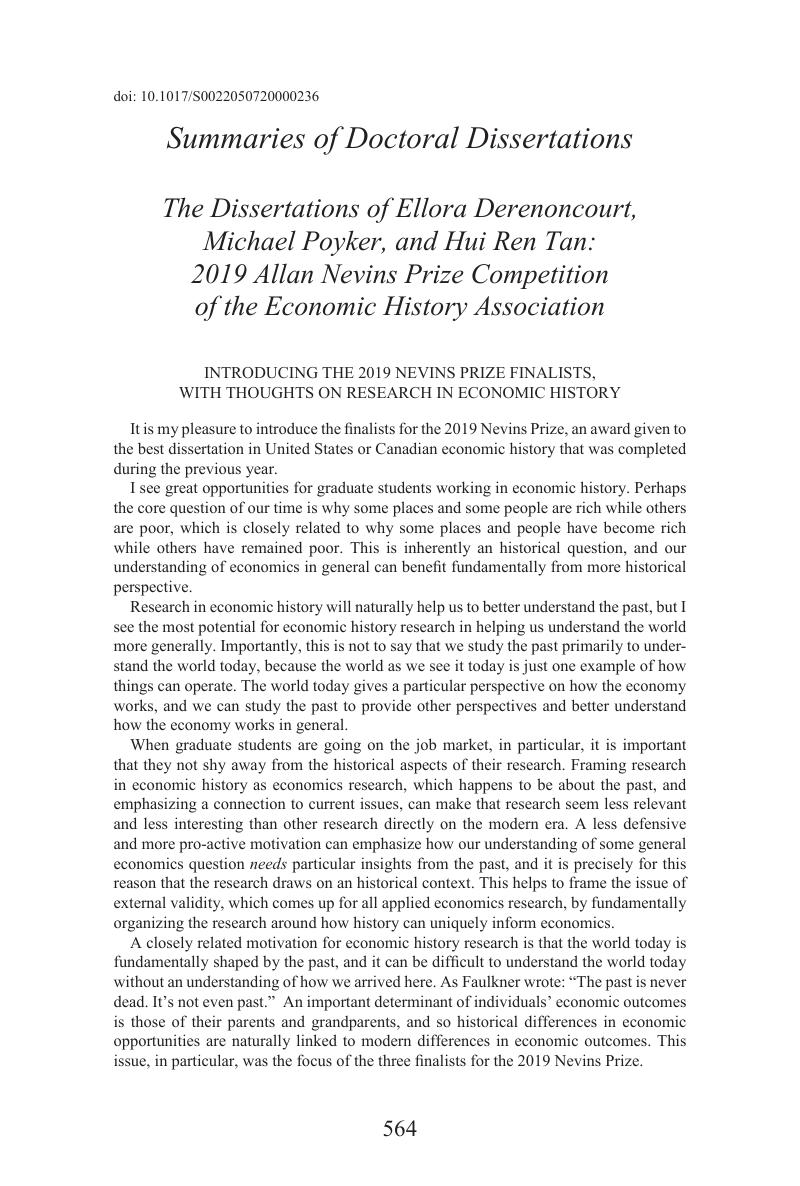No CrossRef data available.
Published online by Cambridge University Press: 03 June 2020

Ellora Derenoncourt, Postdoctoral Research Associate, Princeton University, Princeton, NJ 08544. E-mail: [email protected]. This dissertation was completed under the supervision of Lawrence Katz and Claudia Goldin, Harvard University.
1 I observe these migrants in the complete count 1940 U.S. Census, Integrated Public Use Microdata Series (“IPUMS”) version; see Ruggles et al. (2018).
2 One example is variation in the share of agricultural land planted in cotton. Cotton mechanization accelerated after WWII, contributing to black outmigration from the South (Whatley 1985); variation in cotton acreage thus provides plausible variation in southern county migration rates.
3 Sources include the financial statistics of states and local governments, 1932; the City and County Data Books, 1944–1977; U.S. Census Bureau Annual Survey of Local Governments, 1967–2012; the Biennial Statistics of Education, 1920–1922; 1930–1940 Uniform Crime Reports (“UCR”), courtesy of Price Fishback; UCR 1931, 1936, 1943, and 1950; city crime rates from UCR 1958–1969, Inter-university Consortium for Political and Social Research (“ICPSR”) version; Vera Institute of Justice In Our Backyards Database; IPUMS complete count 1920–1940 U.S. censuses; and Inmates of Institutions, U.S. Census 1960, Table 52.
4 The reform also sharply reduced the adjusted racial earnings gap (i.e., the difference in earnings between black and white workers conditional on observable characteristics) within the treated industries. Black workers were paid 25 log points less than white workers with similar observables (such as education, experience, number of hours worked, etc.) in the treated sectors prior to the introduction of the minimum wage; this difference falls to zero after the reform. We hypothesize that one possible explanation for small employment effects was white employer collusion to pay black workers’ lower wages prior to the reform.
Michael Poyker is a postdoctoral researcher at the Columbia University’s Graduate School of Business, Uris Hall, 126, 3022 Broadway, New York, NY 10027. E-mail: [email protected]. This dissertation was completed in 2018 in the Anderson School of Management at the University California at Los Angeles under the supervision of Christian Dippel, Paola Giuliano (co-chair), Daniel Posner, Peter Rossi, Nico Voigtländer, and Romain Wacziarg (co-chair).
Igratefully acknowledge generous financial support from the Economic History Association and the UCLA Ziman Center for Real Estate.
1 Sources: Census of State and Federal Adult Correctional Facilities, 2005, and FRED. Assuming the share of employed prisoners to be on the 2005 level, they constituted 10 percent of total U.S. manufacturing employment in 2017.
2 For more information on wages and companies working with prisons, see Prisonpolicy.org.
3 The convict labor system was re-established in 1979.
4 Source: U.S. Census of State and Federal Adult Correctional Facilities (1990, 2000, 2005).
Hui Ren Tan, Assistant Professor, Department of Economics, National University of Singapore. E-mail: [email protected]. This dissertation was completed in 2019 in the Department of Economics at Boston University under the supervision of Professors Robert A. Margo, Kevin Lang, M. Daniele Paserman, and James J. Feigenbaum. I acknowledge financial support from the Economic History Association Sokoloff Dissertation Fellowship.
1 CZs are groups of counties characterized by strong within-CZ and weak between-CZ commuting ties (Tolbert and Sizer 1996). Similar results can be obtained with counties instead.
2 The labor market analysis has been completely rewritten in more recent versions of this chapter. Instead of a within-brothers comparison, I compare internal migrants with each other, adapting the approach of Charles, Guryan, and Pan (2019). Specifically, I compare internal migrants who grew up in places with similar labor market structures within the same state, but who ended up in different labor markets as adults due to plausibly exogenous differences in migration costs. Two determinants of migration costs are used: relative distance and historical networks. Consistent with the findings in the original chapter, I find that being in better labor markets improved economic outcomes historically.
1 See Margo (2018) for various issues with the growth of interest in economic history.
Thilo N. H. Albers, Postdoctoral Researcher, Humboldt University, Berlin, Germany and Lund University, Lund, Sweden. E-mail: [email protected]. This dissertation was completed under the supervision of Oliver Accominotti and Albrecht Ritschl, London School of Economics and Political Science. A shorter and, in parts, very similar version of this summary is forthcoming in the European Review of Economic History.
2 Now published in Explorations in Economic History (Albers 2018).
3 See Donaldson’s (2015) excellent review.
4 See Eichengreen and Irwin (2010).
5 See Eichengreen and Irwin (1995).
6 See Estevadeordal, Frantz, and Taylor (2003).
7 Now forthcoming in Economic History Review (Albers 2019).
Anne Sofie Beck Knudsen, Postdoctoral Fellow, Harvard University, Cambridge, MA. E-mail: [email protected]. This dissertation was completed under the supervision of Carl-Johan Dalgaard, University of Copenhagen.
Yuzuru Kumon, Postdoctoral Researcher, University of Bocconi, Milan, Italy. E-mail: [email protected]. This dissertation was completed under the supervision of Gregory Clark, Christopher Meissner, Michael Carter, Peter Lindert, Katherine Eriksson, University of California, Davis.